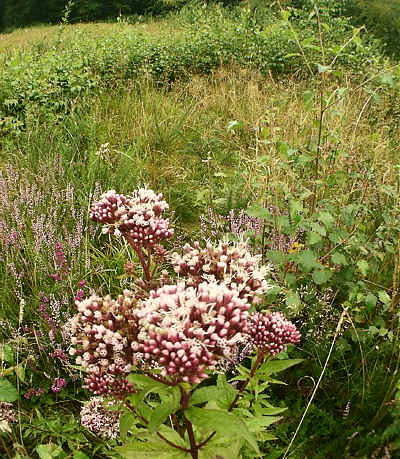|
The Woodland Education Centre |
|
|
The Woodland Education Centre |
|
Ecological Survey 2000
These descriptions
build upon the descriptions of the sections given in the 1999 ecological survey and should
be read in conjunction for maximum benefit. |
Section 9 Description (Hand Weeded)
Observations 1999 - 2000
 |
Bramble had increased in this section to become the dominant species, rather than Silver Birch. |
 |
Other than
this, there was little change in this section from the preceding year. Heather and mosses such as Polytrichum formosum and Thuidium tamarascinum, interspersed with Velvet Bent, continued to dominate the area. Vegetation such as birch saplings and Hemp-agrimony (left), together with Gorse, provided the taller plant cover in the area. |
Dominant Plants in
Section 9 in 2000
with figures from 1999 for comparison.
Characteristic heath species are in bold print
| Species | Overall % frequency | Mean % Cover (all quadrats) | ||
| 2000 | 1999 | 2000 | 1999 | |
| Bramble | 72 | 66 | 22 | 17 |
| Polytrichum formosum | 66 | 69 | 32 | 52 |
| Heather | 63 | 69 | 38 | 42 |
| Thuidium tamarascinum | 63 | 53 | 25 | 27 |
| Velvet Bent | 53 | 47 | 16 | 12 |
| Silver Birch | 50 | 72 | 15 | 12 |
| Common Bent | 47 | 31 | 18 | 8 |
| Hypnum jutlandicum | 38 | 41 | 17 | 24 |
| Yorkshire Fog | 35 | 41 | 5 | 9 |
| Eurhynchium praelongum | 35 | 38 | 9 | 13 |
| Green-ribbed Sedge | 32 | 56 | 8 | 12 |
| European Gorse | 31 | 28 | 10 | 8 |
| Cherry | 22 | 41 | 3 | 5 |
| Pill Sedge | 9 | 38 | 2 | 5 |
| Percentage frequency = the percentage of the total number of quadrats sampled over the whole site which contain the species. For example, a percentage frequency of 100%, means that the species was found in all quadrats sampled. |
>> Continue to Control Section
Ecological Survey 2000 |